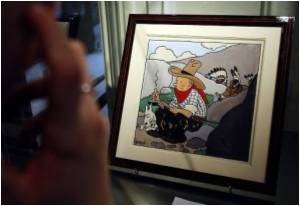With the fall of the eastern communist bloc, cartoons vanished from Cuban TV for more than two decades, quirky Soviet-era cartoons are fueling a wave of nostalgia for middle-aged Cubans.

Of course, it is a generational thing. The shows were broadcast in Cuba from the 1960s to the 1980s.
Some older Cubans remember Disney characters from before the 1959 revolution, like Mickey Mouse and Donald Duck who, not surprisingly, never won the Cold War Cuban government's seal of approval.
And today's kids see a few Cuban cartoons -- and some select international programming.
But for middle-aged Cubans, their childhood heroes came from the Warsaw Pact.
These Soviet-era characters -- along with more made in East Germany or Bulgaria -- are touchstones that still hold a surprisingly warm place in the hearts of Cubans who grew up in a far-flung ally of the Soviet Union.
Advertisement
"I realized that people were getting really into it, and I thought it might go OK as a business," said Darwin Fornes, who designed the brightly colored T-shirts cranked out at a factory in colonial-era Old Havana.
Advertisement
Cubans are relentless punsters, and Fornes named his business "Chamakovich" -- a mix of the Cuban slang for a kid "chamo" and the Eastern European-sounding "kovich."
"These images mean so much to me. They bring my childhood flooding back. That's what happens to everybody who gets caught up in them," said the designer, 28, wearing a yellow T-shirt with the wolf and hare from "Nu, pogodi!" -- translated as "I'll get even, eh".
He had a first lot of 300 T-shirts made and was happy to see them sell out fast -- though Cubans earn the equivalent of under 20 dollars a month.
"People see what we are offering, and I send them to our stand at the street fair," said Fornes whose idea mushroomed out of the interest people had when he spotlighted the cartoon characters on his Facebook page.
"Chamakovich" has drawn enough attention to have earned a spot on a state news program, which in the only Communist-run country in the Americas has not until now put much focus on local business development.
Cuba's government under President Raul Castro, 82, still controls most of the economy, but Cubans are allowed to seek self-employment in a wide range of professions.
Some older Cubans never cared for the artistically uncomplicated Soviet-era cartoon imports, and many parents at the time joked that naughty kids would be punished by being forced to watch them.
But "those of us who were kids when they were on TV enjoyed them a lot," smiled Fornes.
Plenty of Cubans on the island and abroad who agree with him have started collecting images, T-shirts and videoclips of their childhood classics.
Dainerys Machado, a journalist, said she recently downloaded 10 gigabytes of the Soviet-era cartoons as a blast from the past.
Source-AFP









